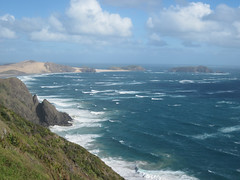 (Editor’s Note: I invited a guest editorial from Kenton Bird, pictured here with Kiwi friend Claire Mikkelson. He attended the rugby match between Wales and NZ with Claire and her husband Pat at the Waikato Stadium in Hamilton. Decked in All Blacks regalia, stocking cap and all, he was quite a sight. I worried that seated with Kiwi fans, his jacket (red—one of the Wales colors) would compromise his comfort. But—no worries, mate!)
(Editor’s Note: I invited a guest editorial from Kenton Bird, pictured here with Kiwi friend Claire Mikkelson. He attended the rugby match between Wales and NZ with Claire and her husband Pat at the Waikato Stadium in Hamilton. Decked in All Blacks regalia, stocking cap and all, he was quite a sight. I worried that seated with Kiwi fans, his jacket (red—one of the Wales colors) would compromise his comfort. But—no worries, mate!)
After reading that the Welsh national rugby team would compete against the All Blacks in Hamilton, I couldn’t resist. I saw the two teams play each other in Wales with fellow Rotary scholar Mike Scott in November 1978 at Cardiff Arms Park. In that match, the All Blacks won 13-12 after a controversial play with just two minutes left in the game. The crowd went berserk!
 The scene at Waikato Stadium was calm by comparison. Uncertain of the weather, I bought a premium seat in the covered grandstand, five rows below the corporate boxes. My section was nearly empty until 15 minutes before the 7:35 kick-off. I could see some red and green (the Welsh colors) a few rows ahead but otherwise, I was surrounded by a sea of black jerseys and parkas.
The scene at Waikato Stadium was calm by comparison. Uncertain of the weather, I bought a premium seat in the covered grandstand, five rows below the corporate boxes. My section was nearly empty until 15 minutes before the 7:35 kick-off. I could see some red and green (the Welsh colors) a few rows ahead but otherwise, I was surrounded by a sea of black jerseys and parkas.
As the pre-game introductions ended, the crowd stood for the national anthems of both countries. In typical Kiwi fashion, the All Black fans were subdued in singing God Defend New Zealand (in Maori, then English). After six months in New Zealand, I finally can sing along. Then, the All Blacks took their places for the haka, the famed Maori chant intended to intimidate enemies before battle. Here’s what an All Blacks pre-game haka looks/sounds like.
Rugby moves faster than American football, known here as “gridiron.” There are two 40-minute halves. The clock stops only if the referee determines an injury is serious enough to interfere with play. There are no “TV time-outs.” Still, numerous rule changes in the past 30 years have slowed the game’s tempo.
More, after losing to the All Blacks a week earlier in Dunedin, Wales adopted a defensive strategy that forced more scrums (the ubiquitous face-to-face ball scramble) and lineouts, which interrupted what I like most about rugby—the non-stop running and passing.
Wales kicked a 3-point goal straight away, but it was their only lead. The All Blacks used their hefty size and home field advantage to open a comfortable half-time lead. With just three minutes remaining, a tuckered Wales team finally scored a “try” (similar to a touchdown). Kiwis fans kindly applauded. In the end, New Zealand scooped yet another victory 29-10.
A bit of a snoozer. Fans told me the All Blacks were eager for their next competition, the Tri-Nation matches with South Africa and Australia. Even the All Blacks’ official Web site described the match as a “dour contest.”
Still, seeing the All Blacks on home turf was thrilling, and a terrific finale to our time in this sport-loving nation. The rollicking offensive show was especially gratifying, too, after the past few weeks of hoopla over the “undefeated” streak of NZ’s All Whites soccer team’s in the World Cup.
The historic rivalry between Wales and NZ began in 1905. Wales won the initial contest 3-0, but has won only twice since then, in 1935 and 1953, both in Cardiff. The All Blacks swamped the Welsh 55-3 in 2003 on the Wales’ last tour of New Zealand, so the visitors were anxious for a better show.
Note: It seems that a typographical error may be responsible for the All Blacks name. During that 1905 tour of Britain, a London sports writer wrote the team played as if they were “all backs.” Someone apparently dropped in an extra “L” and the name stuck.


